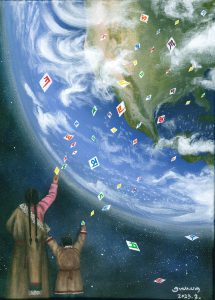ISSN 2768-4261 (Online)

A Journal of Tibetan Literature, Arts and Humanities
Artist’s Statement II
ཀུ་ལ་ཡག Kulha
(Collected and translated by བཀྲ་ཤིས་བདེ་སྐྱིད། Tashi Dekyid Monet)

རི་མོ་འདིའི་མཚོན་དོན་གཙོ་བོ་ནི་བོད་ཀྱི་སྐད་ཡིག་གི་རླུང་རྟ་འདི་འཛམ་གླིང་སྤྱི་ལ་ཁྱབ་པའི་སྨོན་འདུན་སྟེ། སའི་གོ་ལའི་ཡར་ལ་ཀ་ཁ་ག་ང་ཡི་རླུང་རྟ་མཆོད་བཞིན་པ་བྲིས་ཡོད། སྤྱིར་བཏང་རླུང་རྟ་ཡིན་ན་རྟེན་འབྲེལ་བཤད་རྒྱུ་ཡོད་པ་སྟེ། ཁ་ལས་དབང་ཐང་སོགས་གང་གི་ཕྱོགས་ཡིན་ན་ཡར་རྒྱས་སུ་འགྲོ་བཞིན་པའི་ནང་དོན་ཡོད་རེད། དབྱངས་གསལ་ཡི་གེ་ནི་རྩ་བའི་ཚོན་མདོག་ལྔ། གསུམ་དང་དྲུག་ཟེར་བ་སོགས་ཡོད་པ་ནས་མ་གཞིའི་ཚོན་མདོག་དྲུག་པོས་བྲིས་ཡོད། དེས་རྩ་བ་དང་འབྱུང་ཁུངས་ཡིན་པར་བསྟན་པ་སྟེ། རྩ་བའི་ཚོན་མདོག་དྲུག་པོ་མེད་ན་ཚོན་མདོག་གཞན་པ་ལས་ཐུབ་ནི་མ་རེད། ཨ་མ་ཞིག་གིས་བྱིས་པ་ཞིག་ཁྲིད་ཡོད་པ་ནི་མ་འོངས་པའི་སེམས་གཏད་དམ་རེ་བ་བཅོལ་སའམ་རེ་བ་འཁྱུད་ས་ཡོད་པའི་ནང་དོན་དུ་བྲིས་ཡོད། དེ་ནས་ཨ་མའི་གོན་པ་དམར་སྐྱ་ཡིན་པ་ནི་བྱམས་བརྩེ་དང་རེ་བའི་མཚོན་བྱེད་དུ་བྲིས་ཡོད།
This painting (here and on the cover) primarily portrays the hope that the Lungta (literally, wind horse) of Tibetan language—its vitality and power—will spread across the world. This is shown by a mother and her child offering Lungta prayer papers, marked with the letters of the Tibetan alphabet, upward to the planet Earth. Generally, Lungta are explained as tendrel, namely auspicious connections and fortunate conditions, in their signification of [and hope for] flourishing in various areas, such as prosperity and power. The Tibetan alphabet is painted in the six primary colors, from among the various ways of considering the root colors as fivefold, threefold, sixfold, and so forth. This shows how they are foundational and generative, since without the six root colors, it is impossible to create other colors. The scene of a mother bringing a child with her to offer the prayer papers signifies the existence of a place to which one can embrace faith and hope for the future. I have painted the mother’s clothes in the light red color, symbolizing love and hope.
Kulha (ཀུ་ལ་ཡག) is a female painter and multi-media artist from Amdo.
© 2021 Yeshe | A Journal of Tibetan Literature, Arts and Humanities